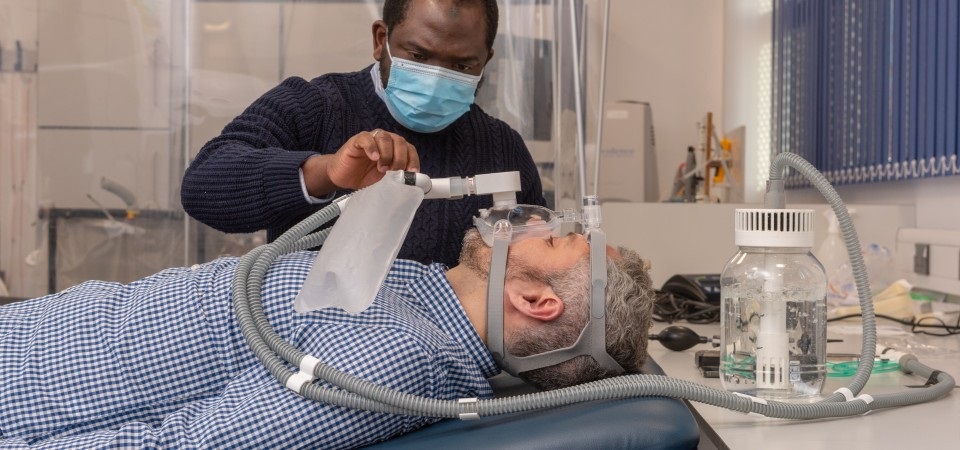The COVID-19 pandemic stretched health facilities globally. Many hospitals ran out of bed spaces and medical supplies, essentially mechanical ventilators and medical oxygen.
The surging number of infected and death cases put everyone on their toes. It pushed scientists to think out of the box searching for effective treatment methods and vaccines for the virus.
At the peak of the pandemic, a team of engineers from Loughborough University, England led by a Nigerian biomedical engineer, Dr Yusuf Bilesanmi, invented a low-cost non-electric ventilator that can help COVID-19 patients with breathing problems.
Named ShiVent, the ventilator has four unique features according to a 2021 report published on the university’s website. It is designed in a simple-to-use way for average health workers, requiring about 30 minutes’ training; can be produced at a very small fraction of the price of the average ventilator; suitable for hospitals with unreliable power and requires a third of the average oxygen consumption of high flow oxygen systems.
- 298 Nigerians repatriated from Libyan prisons
- Subsidy: A/Ibom govt partners Navy on marine transportation
ShiVent has been tested at Loughborough’s National Centre for Sports and Exercise Medicine (NCSEM), the Leicester Royal Infirmary Hospital and had a preliminary clinical functionality test at Glenfield Hospital.
It has also undergone pre-clinical trials in India, Rwanda and Nigeria (Lagos State) attracting a N5m grant from the Lagos State government.
ShiVent is modeled after the principles of bubble continuous positive airway pressure (CPAP), a non-invasive ventilator used for new-born babies earlier developed by Dr Yusuf Shittu of the Nuffield Hospital in Leicester. Shittu is a co-inventor of ShiVent. The others are Gaurav Nanajkar, Pawel Nycz and Ricardo Nasciment.
“The ventilator connects patients to an existing oxygen source and blends air with the high-flow oxygen supply. The patient inhales oxygen to fill up the lungs and then exhales into a water column creating back-end pressure that keeps their airways open,” Bilesanmi told Daily Trust.
He said a clinical trial would be done in Lagos before December 2023 and if successful, massive production for the market would follow.
Why ShiVent fits into Nigerian healthcare
Ventilators are instrumental in the treatment of chronic respiratory diseases such as asthma, pneumonia, hypoxaemia and chronic obstructive pulmonary disease (a lung disease characterized by a persistent reduction of airflow).
These diseases are common in Nigeria and other African countries, making ShiVent relevant even post-COVID. The World Health Organisation (WHO) estimates that more than 90% of COPD deaths occur in low and middle-income countries including Nigeria.
Africa is beset by energy deficit. The World Bank revealed that about 600 million people in sub-Saharan Africa (43% of the region’s population) lack access to energy in 2022. About 85 million of the over 200 million population in Nigeria cannot access the electricity grid. The country currently generates 5,000 megawatts – almost 15% of the 33,000MW the Association of the Nigerian Electricity Distributors says is required for stable electricity.
Nearly half of the population resides in rural areas without access to electricity and this invariably impacts healthcare in those communities. Hospitals struggle to fuel generators to power medical equipment like mechanical ventilators to treat patients.
Prior to the pandemic in 2020 which left many hospitals scrambling for help, oxygen had been in short supply in Nigeria resulting in many preventable deaths. The Federal Ministry of Health disclosed that more than 625,000 deaths occur annually due to diseases associated with hypoxaemia – insufficient oxygen in the blood or low blood oxygen saturation.
The situation eventually birthed the National Policy on Medical Oxygen in 2017 as a pathway to improving access to life-saving medical oxygen to patients in the country.
“Based on currently available data, at least 30 public sector oxygen plants have been established in Nigeria, out of which 21 are said to be functioning; six are of unknown status, and three are non-operational. Moreover, in a 2015 case study of four facility-based plants, factors such as inadequate power supply and wear-and-tear on pipes delivering oxygen to hospital wards were threats to optimising the use of these plans,” according to the policy document.
Little has changed. A shortage of medical oxygen still persists in many hospitals, especially those owned by the government, with patients paying the price.
How does ShiVent come to play?
“It is designed for under-resourced areas where mechanical ventilators are scarce and expensive, with unreliable electricity supply and limited specialist knowledge,” Bilesanmi said.
“At the peak of COVID, Lagos used around 400 cylinders of oxygen a day, at 15 litres of oxygen per minute. ShiVent only requires between 5 litres to 12 litres per minute depending on the patient’s respiratory condition,” he added.
Evaluating ShiVent
Dr Muyiwa Rotimi, a consultant anaesthetist and critical care physician at the Lagos University Teaching Hospital (LUTH) where a preclinical trial on the non-electric ventilator was carried out, said the device would be highly resourceful in managing respiratory distress when it is finally ready.
Rotimi, who is the director of the Intensive Care Unit (ICU) at LUTH, explained that ShiVent would save lives in low and middle-income countries facing erratic power supply.
He said, “It is effective especially when the patient has respiratory failure. It can help both in city and suburban hospitals. If a patient is in distress in the suburbs, it can be deployed pending the time they will be referred to another hospital. At times, the patient may not even need a referral depending on the extent of the respiratory problem.
“It is user-friendly. Some devices can get you confused when you interface with them and if care is not taken you can cause more harm than helping the patient if you press the wrong button.
“It can also be used anywhere: in the ward, in the emergency room, recovery room and accident scene so far as oxygen is available. It doesn’t have to necessarily be in the intensive care unit, unlike the electric ventilators.
“It also conserves oxygen. When you power an electric ventilator it comes at a high flow and needs enough oxygen to drive it, but ShiVent operates at low pressure. The higher the pressure is, the more the oxygen consumption.
“Assessors have made their comments and corrections have been made. We are at the approval level now. Subsequently, we will do a clinical trial and make it official. With what we have done and the positive reviews from other countries, we don’t expect any contrary result.”
Rotimi, however, said the device has its limits. Hypothetically, if a patient is down at zero and needs to get to 100, ShiVent could only help the patient up to 60-70%, he explained.
“It can handle mild, moderate and early severe respiratory failure, but it can’t be used for unconscious patients and patients without respiratory effort. The patients must have respiratory effort before it can be deployed. If the respiratory effort is 12-16 per minute breathing and the patient is doing 32-40 (breathing fast) because they are asthmatic or have pneumonia, it will step down the breathing and make it balance,” he said.
A Professor of Paediatrics and a fellow of the West African College of Physicians, Mustafa Asani, said if successful, the invention would be apt for hospitals in Nigeria.
“Where you can’t vouch for constant electricity supply like Nigeria, such an invention is required considering that a ventilator is very important to the care of patients with respiratory problems,” he added.
Kamilu Karaye, a cardiologist and Professor of Medicine at the Bayero University Kano, noted that a non-electric ventilator is an invention government and other stakeholders should embrace as one of the potential solutions to power failure in hospitals.
He stated, “Such an invention will be great for us in Nigeria because most of our hospitals nowadays are powered by generators which are put off for some hours because of high fuel prices. The ventilator will make a lot of sense if it comes to reality. It will help the patients.
“For sure, electricity is not going to become stable in Nigeria in years to come. So if we have a non-electric ventilator, it will surely help even if it means patients will be placed on it whenever there is a power outage. It is a potential solution to our problem and the government can embrace it.”

 Join Daily Trust WhatsApp Community For Quick Access To News and Happenings Around You.
Join Daily Trust WhatsApp Community For Quick Access To News and Happenings Around You.


